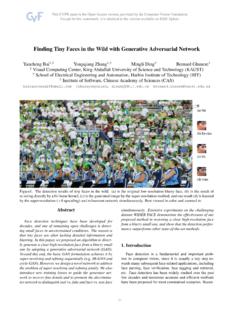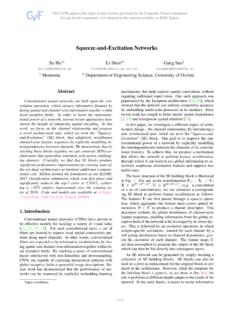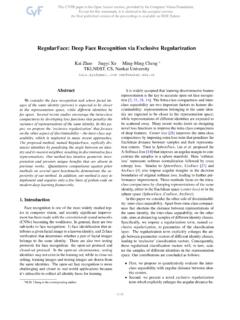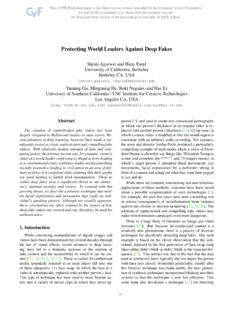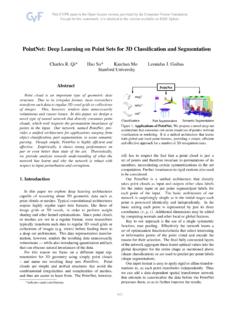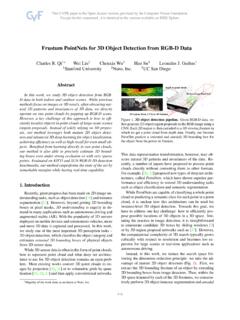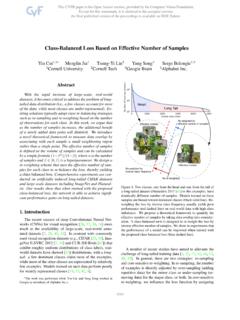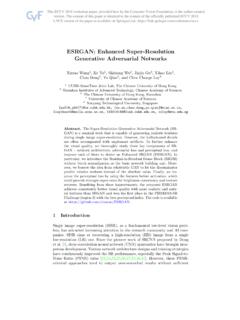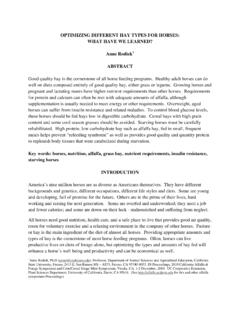Transcription of What Have We Learned From Deep Representations for …
1 what have we Learned from deep Representations for action recognition?Christoph Feichtenhofer*TU PinzTU P. WildesYork University, ZissermanUniversity of the success of deep models has led to their deploymentin all areas of computer vision, it is increasingly impor-tant to understand how these Representations work and whatthey are capturing. In this paper, we shed light on deep spa-tiotemporal Representations by visualizing what two-streammodels have Learned in order to recognize actions in show that local detectors for appearance and motion ob-jects arise to form distributed Representations for recogniz-ing human actions.
2 Key observations include the , cross-stream fusion enables the learning of true spa-tiotemporal features rather than simply separate appear-ance and motion features. Second, the networks can learnlocal Representations that are highly class specific, but alsogeneric Representations that can serve a range of , throughout the hierarchy of the network, features be-come more abstract and show increasing invariance to as-pects of the data that are unimportant to desired distinc-tions ( motion patterns across various speeds). Fourth,visualizations can be used not only to shed light on learnedrepresentations, but also to reveal idiosyncracies of trainingdata and to explain failure cases of the docu-ment is best viewed offline where figures play on MotivationPrincipled understanding of how deep networks operateand achieve their strong performance significantly lags be-hind their realizations.
3 Since these models are being de-ployed to all fields from medicine to transportation, this is-sue becomes of ever greater importance. Previous work hasyielded great advances in effective architectures for recog-nizing actions in video, with especially significant stridestowards higher accuracies made by deep spatiotemporalnetworks [2,8,32,39,40]. However, what these mod-els actually learn remains unclear, since their compositionalstructure makes it difficult to reason explicitly about theirlearned Representations . In this paper we use spatiotempo-*C.
4 Feichtenhofer made the primary contribution to this work and there-fore is listed first. Others contributed equally and are listed alphabetically.(a)(b)(c)(d)Figure 1. Studying a single filter at layer conv5fusion: (a) and(b) show what maximizes the unit at the input: multiple colouredblobs in the appearance input (a) and moving circular objects atthe motion input (b). (c) shows a sample clip from the test set,and (d) the corresponding optical flow (where the RGB channelscorrespond to the horizontal, vertical and magnitude flow compo-nents respectively).
5 Note that (a) and (b) are optimized from whitenoise under regularized spatiotemporal viewed inAdobe Reader where (b)-(d) should play as regularized activation maximization [23,25,31,38,42] to visualize deep two-stream Representations [32] andbetter understand what the underlying models have an example, in highlight a single inter-esting unit at the last convolutional layer of the VGG-16 Two-Stream Fusion model [8], which fuses appearance andmotion features. We visualize the appearance and motioninputs that highly activate this filter.
6 When looking at theinputs, we observe that this filter is activated by differentlycoloured blobs in the appearance input and by linear mo-tion of circular regions in the motion input. Thus, this unitcould support recognition of the Billiards class in UCF101,and we show in sample Billiards clip from the testset of UCF101. Similar to emergence of object detectors forstatic images [1,46], here we see the emergence of a spa-tiotemporal representation for an action. While [1,46] au-tomatically assigned concept labels to Learned internal rep-resentations by reference to a large collection of labelledinput samples, our work instead is concerned with visualiz-ing the network s internal Representations without appeal toany signal at the input and thereby avoids biasing the visu-alization via appeal to a particular set of , we can understand deep networks from twoviewpoints.
7 First, thearchitectural viewpointthat consid-ers a network as a computational structure ( a directedacyclic graph) of mathematical operations in feature space( affine scaling and shifting, local convolution and pool-17844ing, nonlinear activation functions, etc.). In previous work,architectures (such as Inception [36], VGG16 [33], ResNet[14]) have been designed by composing such computationalstructures with a principle in mind ( a direct path forbackpropagation in ResNet). We can thus reason abouttheir expected predictions for given input and the quanti-tative performance for a given task justifies their design,but this does not explain how a network actually arrivesat these results.
8 The second way to understand deep net-works is therepresentational viewpointthat is concernedwith the Learned representation embodied in the network pa-rameters. Understanding these Representations is inherentlyhard as recent networks consist of a large number of param-eters with a vast space of possible functions they can hierarchical nature in which these parameters are ar-ranged makes the task of understanding complicated, espe-cially for ever deeper Representations . Due to their com-positional structure it is difficult to explicitly reason aboutwhat these powerful models actually have this paper we shed light on deep spatiotemporal net-works by visualizing what excites the Learned models us-ing activation maximization by backpropagating on the in-put.
9 We are the first to visualize the hierarchical featureslearned by a deep motion network. Our visual explanationsare highly intuitive and provide qualitative support for thebenefits of separating into two pathways when processingspatiotemporal information a principle that has also beenfound in nature where numerous studies suggest a corre-sponding separation into ventral and dorsal pathways of thebrain [9,11,24] as well as the existence of cross-pathwayconnections [19,29].2. Related work on visualizationThe current approaches to visualization can be groupedinto three types, and we review each of them in for given inputshave been used in severalapproaches to increase the understanding of deep straightforward approach is to record the network activi-ties and sample over a large set of input images for findingthe ones that maximize the unit of interest [1,43,46,47].
10 Another strategy is to use backpropagation to highlightsalient regions of the hidden units [22,30,31,45].Activation maximization (AM)has been used by back-propagating on, and applying gradient ascent to, the inputto find an image that increases the activity of some neuronof interest [5]. The method was employed to visualize unitsof Deep Belief Networks [5,15] and adopted for deep auto-encoder visualizations in [21]. The AM idea was first ap-plied to visualizing ConvNet Representations trained on Im-ageNet [31]. That work also showed that the AM techniquesgeneralize the deconvolutional network reconstruction pro-cedure introduced earlier [43], which can be viewed as aspecial case of one iteration in the gradient based activationmaximization.
